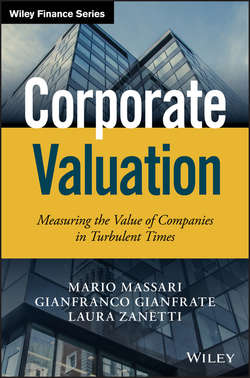Читать книгу Corporate Valuation - Massari Mario - Страница 8
На сайте Литреса книга снята с продажи.
Chapter 1
Introduction
1.2 VALUATION METHODS: AN OVERVIEW
ОглавлениеFinance textbooks offer several different options to perform the valuation of a firm or of an acquisition. Furthermore, financial institutions and consulting firms typically work out tailor-made models expanding the spectrum of available techniques. In the end, in assessing value of firms belonging to particular industries, several empirical techniques have gained quite a standing among practitioners.
Given the number of methodologies made available by theorists and practitioners, we find it useful, before getting into the core of this book, to explore a classification of the most widely used methodologies (Exhibit 1.1).
Exhibit 1.1 An overview of the main valuation methodologies/approaches
Exhibit 1.1 shows that the methodologies available (excluding simplistic empirical approaches) can be grouped into four fundamental approaches, each a function of the relevant link between corporate value and relevant value driver. A methodology is then a choice of the relevant driver, chosen out of the above-mentioned four approaches in order to assess value:
1. Income approach
2. Economic profit approach
3. Market approach
4. Net asset approach
The first approach expresses the value of a company or an investment as a function of the expected returns it generates. The so-called financial method (or, better, discounted cash flow, or DCF) falls into this approach and is the methodology most consistent with those found in standard finance textbooks.
The second approach is based on the idea that the value of a company is determined by two components: net asset value and earnings that exceed the “normal” return of the assets (economic profit is then the difference – when positive – between realized returns and “normal” industry returns).
The third approach is empirical: valuations are performed through a comparison with comparable assets traded on the market.
Finally, the fourth approach determines value from the estimation of the assets (tangible and intangible) that, net of the liabilities, constitute the net invested capital of the firm.
1.2.1 Common Practices in the Accounting and Financial Communities
Often, professionals separate methodologies into two main approaches to valuation: the first is the standard practice adopted by the financial community; the second one is the most widely used by accounting professionals.
The common practice in the financial community can be traced back to the methodologies adopted by investment and merchant banks – in particular:
● The DCF method based on the discounting of future cash flows derived from the company's business plan or assumed by the analyst
● Stock market multiples or multiples derived from comparable transactions
In other professional fields, the other methods set forth in Exhibit 1.1 seem to be preferred, partly because of cultural affinities and partly because of the specific goal of the valuation.
Indeed, some methods (particularly those based on excess earnings):
● better fit into some economic and accounting environment;
● follow, therefore, a logic more understandable to the actors for whose benefit the valuation is performed; and
● allow one to effectively and convincingly deal with special valuation problems, such as third-party interests or tax benefit valuations.
1.2.2 Approach of This Book
Despite the widespread use of alternative methodologies, most of this book will be devoted to the DCF analysis.
The reason for this choice is that DCF valuation processes allow a clear focus on the fundamental principles underlying valuation conditions that need to be met, and also when the professional believes a different methodology to better fit the final valuation objective.
In this chapter, we introduce, following a logical order that teaching experience has shown to be effective, the basic principles and themes that form the pillars of the DCF valuation approach:
● The net present value (NPV) principle
● How to deal with uncertainty
● The relationship between uncertainty and value
● The need for preventing, when possible, subjective judgments in value determination
